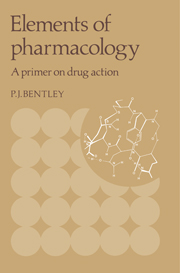Book contents
- Frontmatter
- Contents
- Preface
- 1 Introduction
- 2 Scope of pharmacology
- 3 Where do drugs come from?
- 4 The names of drugs
- 5 Techniques and methods of pharmacology
- 6 Absorption, distribution, and elimination of drugs; pharmacokinetics
- 7 The nature of responses to drugs
- 8 Receptor theory
- 9 Relationship of chemical structure to biological activity
- 10 Roles of the cell membrane in responses to drugs
- 11 Clinical aspects of the actions of drugs
- 12 Conclusion
- References
- Glossary of drugs named in the text
- Index
8 - Receptor theory
Published online by Cambridge University Press: 29 January 2010
- Frontmatter
- Contents
- Preface
- 1 Introduction
- 2 Scope of pharmacology
- 3 Where do drugs come from?
- 4 The names of drugs
- 5 Techniques and methods of pharmacology
- 6 Absorption, distribution, and elimination of drugs; pharmacokinetics
- 7 The nature of responses to drugs
- 8 Receptor theory
- 9 Relationship of chemical structure to biological activity
- 10 Roles of the cell membrane in responses to drugs
- 11 Clinical aspects of the actions of drugs
- 12 Conclusion
- References
- Glossary of drugs named in the text
- Index
Summary
Drugs and hormones usually act at relatively low concentrations, frequently at about 10−9 M, although concentrations as low as 10−12 M are not uncommon. Their effects are also usually remarkably specific in relation to their chemical structure. Specific properties of drugs have been recognized for about 100 years, and led J. N. Langley in 1905 to suggest the presence of a specific “receptive substance” to account for the actions of curare and nicotine at the neuromuscular junction. P. Ehrlich made a similar suggestion in 1913 to explain the specific actions of certain dyes on bacteria. Although receptors remained somewhat enigmatic hypothetical entities until quite recently, they provided a basis for the theoretical analysis of the quantitative actions of drugs, both in eliciting a response (agonists) and in antagonizing it (antagonists). Several such theories to account for the actions of drugs have been proposed. The two major current ones are the occupation theory, originally developed about 50 years ago by A. J. Clark at University College London, and the rate theory, proposed by W. D. M. Paton at Oxford in 1961 (Paton, 1961). Occupation theory has been somewhat modified, especially by E. J. Ariens (see Ariens and Simonis, 1964a,b), and is currently the more favored one. It should, however, be emphasized that no single theory can completely account for all the various phenomena associated with drug action, and it is possible that some groups of drugs act differently, so that a unitary theory may not be appropriate. In addition, conclusive experimental proof of such theories is probably not feasible, although they can provide a useful and productive framework for understanding the mechanisms by which drugs work.
- Type
- Chapter
- Information
- Elements of PharmacologyA Primer on Drug Action, pp. 44 - 71Publisher: Cambridge University PressPrint publication year: 1981



